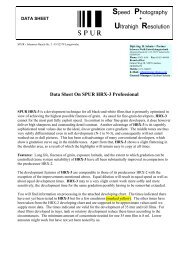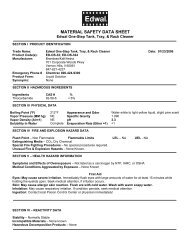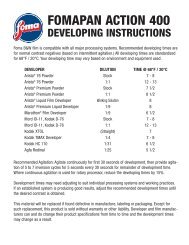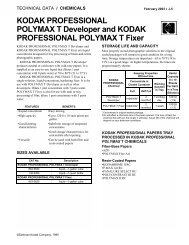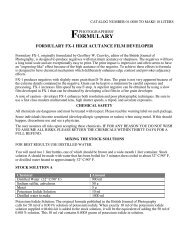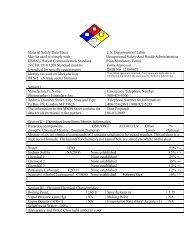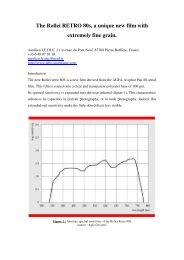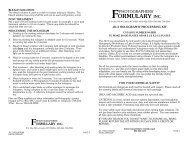Tech Pub J-78 - Kodak
Tech Pub J-78 - Kodak
Tech Pub J-78 - Kodak
Create successful ePaper yourself
Turn your PDF publications into a flip-book with our unique Google optimized e-Paper software.
TECHNICAL DATA / CHEMICALS<br />
October 2002 • J-<strong>78</strong><br />
KODAK PROFESSIONAL<br />
D-76 Developer<br />
KODAK PROFESSIONAL D-76 Developer provides full<br />
emulsion speed and excellent shadow detail with normal<br />
contrast, and produces fine grain with a variety of<br />
continuous-tone black-and-white films. For greater<br />
sharpness, but with a slight increase in graininess, you can<br />
use a 1:1 dilution of this developer. It yields a long density<br />
range, and its development latitude allows push processing<br />
with relatively low fog.<br />
Proper replenishment of D-76 Developer with KODAK<br />
PROFESSIONAL D-76R Replenisher will increase the<br />
capacity of the developer and maintain process consistency<br />
without an increase in the development time.<br />
AGITATION<br />
Proper agitation is very important for consistent and uniform<br />
results. Agitation helps remove the by-products of<br />
development from the surface of the film so that fresh<br />
developer can act on the exposed silver halide in the<br />
emulsion. Because agitation affects the rate of development,<br />
particularly in high-density areas, you can achieve consistent<br />
negative quality only if agitation is uniform over the whole<br />
surface of the film, and when the degree of agitation is<br />
similar for each film or batch of films.<br />
Agitation should always consist of irregular or random<br />
movements that will not cause solution currents to flow over<br />
the film constantly in any one direction; these currents<br />
increase film density along their paths, causing<br />
nonuniformity.<br />
Agitating Rolls in a Small Tank: The times given for<br />
small-tank processing are based on the following agitation<br />
procedure:<br />
1. Fill the empty tank with developer.<br />
2. Start the timer. In the dark, carefully place the loaded<br />
reel into the developer solution.<br />
3. Quickly attach the top to the tank. Firmly tap the bottom<br />
of the tank against the work surface from a height of<br />
approximately 2.5 cm (1 inch) to dislodge air bubbles<br />
from the surface of the film. Air bubbles can interfere<br />
with development and produce low-density circles on<br />
the film.<br />
4. Provide initial agitation of up to 5 cycle, depending on<br />
your results. For KODAK PROFESSIONAL T-MAX<br />
Films, provide initial agitation of 5 to 7 cycles in<br />
5 seconds. For an invertible tank, one cycle consists of<br />
rotating the tank upside down and then back to the<br />
upright position. For a noninvertible tank, one cycle<br />
consists of sliding the tank back and forth over a<br />
25.4 cm (10-inch) distance. With tanks that have a<br />
handle for turning the reel, rotate the reel back and forth<br />
gently through about one-half turn at a rate of one cycle<br />
per second during the agitation intervals. Steps 2<br />
through 4 will take approximately 7 to 20 seconds,<br />
depending on the type of tank.<br />
5. Let the tank sit for the remainder of the first 30 seconds.<br />
6. After the first 30 seconds, agitate for 5 seconds at<br />
30 second intervals. Agitation should consist of 2 to<br />
5 cycles, depending on the contrast you need and the<br />
type of tank.<br />
Agitating Short Rolls in a Large Tank: You can process<br />
several short rolls (1.5 metres [5 feet] or less) in a large tank.<br />
Wind each roll onto a spiral reel. Load the reels on a rack, in<br />
a basket, or on a spindle, and place the rack, basket, or<br />
spindle in the tank (typically a 3.8-litre [1-gallon] or a<br />
13-litre [3 1 ⁄2-gallon] tank). Many racks can hold up to<br />
30 rolls of 35 mm film or 18 rolls of 120-size film. Use the<br />
following agitation procedure:<br />
1. Start the timer. Lower the rack, basket, or spindle into<br />
the developer, and tap it quickly and sharply against the<br />
tank to dislodge air bubbles from the surface of the film.<br />
Air bubbles can interfere with development and produce<br />
low-density circles on the film.<br />
2. Agitate the film continuously for the first 15 to<br />
30 seconds by raising and lowering the rack, basket, or<br />
spindle approximately 1 cm ( 1 ⁄2 inch). Be sure to keep<br />
the reels in the solution. Do not agitate the rack, basket,<br />
or spindle for the remainder of the first minute.<br />
3. Agitate once each minute (after the first minute) by<br />
lifting the rack, basket, or spindle completely out of the<br />
developer, tilting it approximately 30 degrees to drain it<br />
for 5 to 10 seconds, and reimmersing it. Alternate the<br />
direction of tilting the rack, basket, or spindle.<br />
Agitating Sheet Film in a Tray: To process an individual<br />
sheet, start the timer, and slide the film smoothly into the<br />
©Eastman <strong>Kodak</strong> Company, 2002
developer. Rock the tray immediately to make sure the film<br />
is covered with solution. To agitate, first raise the left side of<br />
the tray about 1.9 cm ( 3 ⁄4 inch), lower it smoothly, and then<br />
immediately raise and lower the side nearest to you. Next,<br />
raise and lower the right-hand side, then the near side again.<br />
This agitation cycle takes about 8 seconds. Agitate<br />
continuously throughout the development time.<br />
To process 2 to 6 sheets together, follow the procedure<br />
below, which includes a prewet step. Prewetting will prevent<br />
the sheets from sticking together and will promote even<br />
development.<br />
1. Fill a tray with water that is at the same temperature as<br />
the developer.<br />
2. Immerse the sheets one at a time, emulsion side up, in<br />
the tray of water. Make sure that each sheet is covered<br />
with water before inserting the next one. Agitate by<br />
moving the bottom sheet to the top of the stack every<br />
few seconds, and go through the stack twice. Be careful<br />
that the corners of the sheet you are handling do not<br />
scratch the sheet under it.<br />
3. Take the bottom sheet out of the tray of water, drain it<br />
for a few seconds, and place it in the developer emulsion<br />
side up. Start the timer. Make sure that the sheet is<br />
covered with developer, and transfer the rest of the<br />
sheets to the developer quickly, one at a time, in the<br />
same way. Interleave the stack, from bottom to top, until<br />
development is complete.<br />
Note: When you use interleaving agitation, it is<br />
important to go through the stack of films completely.<br />
Rotate the first sheet in the developer 180 degrees from<br />
the rest of the stack so that the notch is at the opposite<br />
end. This identifies it as the first sheet in; be sure that it<br />
is the first sheet you remove from the solution.<br />
4. At the end of the development time, transfer the sheets<br />
to the stop bath one at a time. To avoid contaminating<br />
the developer with stop bath, use one hand for lifting the<br />
sheets from the developer and the other hand for placing<br />
them in the stop bath.<br />
Agitating Sheet Film in a Large Tank: Be sure to separate<br />
the sheets by at least 1 cm ( 1 ⁄2 inch). When you process films<br />
of different sizes together in the same tank, such as<br />
8 x 10-inch and 4 x 5-inch films, separate the hangers<br />
containing the different-size films with a hanger loaded with<br />
an 8 x 10-inch sheet of acetate or scrap film to avoid uneven<br />
development or scratching of the larger sheets. This<br />
unevenness is caused by turbulence around the central frame<br />
of the multiple-film hanger during agitation. To agitate a<br />
sheet of film or a batch of sheet films in hangers in a tank,<br />
follow this procedure:<br />
1. Start the timer. Lower the hangers as a unit into the<br />
developer. Tap the hangers sharply against the rim of the<br />
tank two or three times to dislodge air bubbles from the<br />
surface of the film. (Air bubbles can interfere with<br />
development and produce low-density circles on the<br />
film.)<br />
2. Allow the hangers to remain undisturbed for the<br />
remainder of the first minute.<br />
3. Lift all the hangers out of the solution and tilt them<br />
almost 90 degrees to the left. Reimmerse the hangers,<br />
lift them out again, and then tilt them almost 90 degrees<br />
to the right. Do this as quickly and smoothly as<br />
possible—in about 5 to 7 seconds.<br />
4. After you reimmerse the hangers, check their spacing.<br />
5. Repeat this agitation cycle once every minute during the<br />
development time.<br />
Note: Each agitation cycle should take about 6 seconds.<br />
When you process large sheets of film (e.g., 8 x 10 inches),<br />
be careful not to dislodge them from the hangers by lifting<br />
them from the solution too quickly.<br />
DEVELOPMENT TIMES<br />
The development times in the following tables are<br />
starting-point recommendation; for critical applications, run<br />
tests to determine the best development time. If your films<br />
are consistently too low in contrast, increase the<br />
development time slightly (10 to 15 percent); if they are too<br />
contrasty, decrease the development time slightly (10 to<br />
15 percent).<br />
If you use D-76 Developer diluted 1:1, dilute it just before<br />
you use it, and discard it after processing the batch of film.<br />
Before using the diluted developer, make certain that there<br />
are no air bubbles in the solution. If air is coming out of the<br />
solution and forming bubbles, let the solution stand until the<br />
bubbles dissipate. Don’t reuse or replenish the diluted<br />
solution. You can develop one 135-3 roll (80 square inches)<br />
in 473 mL (16 ounces) or two rolls together in 946 mL<br />
(one quart) of diluted developer. If you process one<br />
135-36 roll in a 237 mL (8-ounce) tank or two 135-36 rolls<br />
in a 473 mL (16-ounce) tank, increase the development time<br />
by 10 percent (see the following tables).<br />
2 KODAK PROFESSIONAL D-76 Developer • J-<strong>78</strong>
Roll Films<br />
KODAK Film<br />
KODAK PROFESSIONAL D-76 Developer (Full Strength)<br />
18°C<br />
(65°F)<br />
20°C<br />
(68°F)<br />
Small Tank *<br />
21°C<br />
(70°F)<br />
Development Times (Minutes)<br />
22°C<br />
(72°F)<br />
24°C<br />
(75°F)<br />
18°C<br />
(65°F)<br />
20°C<br />
(68°F)<br />
Large Tank †<br />
21°C<br />
(70°F)<br />
22°C<br />
(72°F)<br />
24°C<br />
(75°F)<br />
T-MAX 100 Professional 10 1 ⁄2 9 8 7 6 11 1 ⁄2 10 9 8 6 1 ⁄2<br />
PROFESSIONAL T-MAX 100 7 1 ⁄2 6 1 ⁄2 5 1 ⁄2 5 4 1 ⁄4 8 1 ⁄4 7 1 ⁄4 6 1 ⁄2 5 3 ⁄4 4 3 ⁄4<br />
T-MAX 400 Professional and<br />
PROFESSIONAL T-MAX 400<br />
9 8 7 6 1 ⁄2 5 1 ⁄2 10 9 8 7 1 ⁄2 6 1 ⁄2<br />
T-MAX P3200 Professional See the table below See the table below<br />
VERICHROME Pan 8 7 5 1 ⁄2 5 4 1 ⁄2 9 8 7 6 5<br />
PLUS-X Pan / PX<br />
PLUS-X Pan Professional / PXP<br />
6 1 ⁄2 5 1 ⁄2 5 4 1 ⁄2 3 3 ⁄4 7 1 ⁄2 6 1 ⁄2 6 5 1 ⁄2 4 1 ⁄2<br />
PROFESSIONAL PLUS-X 125 6 1 ⁄2 5 1 ⁄2 5 4 1 ⁄2 4 7 1 ⁄4 6 1 ⁄4 5 3 ⁄4 5 1 ⁄4 4 1 ⁄2<br />
TRI-X Pan 9 8 7 1 ⁄2 6 1 ⁄2 5 1 ⁄2 10 9 8 7 6<br />
TRI-X Pan Professional 9 8 7 1 ⁄2 7 6 10 9 8 1 ⁄2 8 7<br />
PROFESSIONAL TRI-X 400<br />
Film / 400TX<br />
8 6 3 ⁄4 6 1 ⁄4 5 1 ⁄2 4 3 ⁄4 9 1 ⁄4 7 3 ⁄4 7 6 1 ⁄2 5 1 ⁄2<br />
PROFESSIONAL TRI-X 320<br />
Film / 320TXP<br />
* With agitation at 30-second intervals.<br />
† With agitation at 1-minute intervals.<br />
10 9 8 1 ⁄4 7 1 ⁄2 6 1 ⁄2 11 1 ⁄2 10 1 ⁄4 9 1 ⁄2 8 3 ⁄4 7 1 ⁄2<br />
High Speed Infrared 9 1 ⁄2 8 1 ⁄2 7 1 ⁄2 7 6 10 9 8 7 1 ⁄2 6 1 ⁄2<br />
Note: Tank development times shorter than 5 minutes may produce poor uniformity.<br />
KODAK T-MAX P3200 Professional Film in KODAK<br />
PROFESSIONAL D-76 Developer (Full Strength)<br />
Exposed<br />
at EI<br />
20°C<br />
(68°F)<br />
* With agitation at 30-second intervals.<br />
Development Times (Minutes)<br />
Small Tank *<br />
21°C<br />
(70°F)<br />
24°C<br />
(75°F)<br />
27°C<br />
(80°F)<br />
29°C<br />
(85°F)<br />
400/27° 10 1 ⁄2 9 1 ⁄2 7 1 ⁄2 6 4 1 ⁄2<br />
800/30° 11 10 8 6 1 ⁄2 5<br />
1600/33° 11 1 ⁄2 10 1 ⁄2 8 1 ⁄2 7 5 1 ⁄2<br />
3200/36° 15 13 1 ⁄2 11 8 1 ⁄2 7 1 ⁄2<br />
6400/39° 17 1 ⁄2 16 12 1 ⁄2 10 1 ⁄2 9<br />
Note: Tank development times shorter than 5 minutes may<br />
produce poor uniformity.<br />
KODAK PROFESSIONAL T-MAX P3200 Film in KODAK<br />
PROFESSIONAL D-76 Developer (Full Strength)<br />
Exposed<br />
at EI<br />
20°C<br />
(68°F)<br />
* With agitation at 30-second intervals.<br />
Development Times (Minutes)<br />
Small Tank *<br />
21°C<br />
(70°F)<br />
24°C<br />
(75°F)<br />
27°C<br />
(80°F)<br />
29°C<br />
(85°F)<br />
400/27° 10 1 ⁄2 9 1 ⁄2 7 1 ⁄2 6 5<br />
800/30° 11 1 ⁄2 10 1 ⁄2 8 1 ⁄2 6 1 ⁄2 5 1 ⁄2<br />
1600/33° 12 1 ⁄2 11 1 ⁄2 9 7 1 ⁄2 6<br />
3200/36° 14 13 10 1 ⁄2 8 1 ⁄2 6 1 ⁄2<br />
6400/39° 15 1 ⁄2 14 11 1 ⁄2 9 7 1 ⁄2<br />
Note: Tank development times shorter than 5 minutes may<br />
produce poor uniformity.<br />
KODAK PROFESSIONAL D-76 Developer • J-<strong>78</strong> 3
Sheet Films<br />
KODAK Film<br />
* With agitation at 30-second intervals.<br />
† With agitation at 1-minute intervals.<br />
18°C<br />
(65°F)<br />
KODAK PROFESSIONAL D-76 Developer (1:1)<br />
20°C<br />
(68°F)<br />
Small Tank *<br />
21°C<br />
(70°F)<br />
Development Times (Minutes)<br />
22°C<br />
(72°F)<br />
24°C<br />
(75°F)<br />
18°C<br />
(65°F)<br />
20°C<br />
(68°F)<br />
Large Tank †<br />
21°C<br />
(70°F)<br />
22°C<br />
(72°F)<br />
T-MAX 100 Professional 14 1 ⁄2 12 11 10 8 1 ⁄2 — — — — —<br />
PROFESSIONAL T-MAX 100 11 9 1 ⁄2 8 1 ⁄2 7 1 ⁄2 6 1 ⁄4 — — — — —<br />
T-MAX 400 Professional and<br />
PROFESSIONAL T-MAX 400<br />
14 1 ⁄2 12 1 ⁄2 11 10 9 — — — — —<br />
VERICHROME Pan 11 9 8 7 6 12 1 ⁄2 10 9 8 7<br />
PLUS-X Pan<br />
PLUS-X Pan Professional<br />
8 7 6 1 ⁄2 6 5 10 9 8 7 1 ⁄2 7<br />
PROFESSIONAL PLUS-X 125 10 8 1 ⁄2 7 3 ⁄4 7 1 ⁄4 6 11 1 ⁄4 9 3 ⁄4 8 3 ⁄4 8 6 3 ⁄4<br />
TRI-X Pan 11 10 9 1 ⁄2 9 8 13 12 11 10 9<br />
PROFESSIONAL TRI-X 400 Film /<br />
400TX<br />
10 3 ⁄4 9 3 ⁄4 9 8 1 ⁄2 7 3 ⁄4 12 1 ⁄4 11 10 1 ⁄2 9 3 ⁄4 8 3 ⁄4<br />
PROFESSIONAL TRI-X 320 Film /<br />
320TXP<br />
KODAK Sheet Film<br />
* With continuous agitation.<br />
† With agitation at 1-minute intervals.<br />
24°C<br />
(75°F)<br />
14 1 ⁄4 12 3 ⁄4 11 3 ⁄4 10 3 ⁄4 9 1 ⁄4 — — — — —<br />
KODAK PROFESSIONAL D-76 Developer (Full Strength)<br />
18°C<br />
(65°F)<br />
20°C<br />
(68°F)<br />
Tray *<br />
21°C<br />
(70°F)<br />
22°C<br />
(72°F)<br />
Development Times (Minutes)<br />
24°C<br />
(75°F)<br />
18°C<br />
(65°F)<br />
20°C<br />
(68°F)<br />
Large Tank †<br />
21°C<br />
(70°F)<br />
22°C<br />
(72°F)<br />
T-MAX 100 Professional 9 1 ⁄2 7 6 1 ⁄2 5 1 ⁄2 5 11 1 ⁄2 9 1 ⁄2 8 1 ⁄2 7 1 ⁄2 7<br />
PROFESSIONAL T-MAX 100 6 3 ⁄4 5 3 ⁄4 5 1 ⁄4 4 3 ⁄4 4 8 1 ⁄4 7 1 ⁄4 6 1 ⁄2 5 3 ⁄4 4 3 ⁄4<br />
T-MAX 400 Professional and<br />
PROFESSIONAL T-MAX 400<br />
9 1 ⁄2 7 6 1 ⁄2 6 5 1 ⁄2 11 10 9 8 7<br />
TRI-X Pan Professional / TXT 6 5 1 ⁄2 5 5 4 1 ⁄2 7 1 ⁄2 7 6 1 ⁄2 6 5 1 ⁄2<br />
PROFESSIONAL TRI-X 320 Film /<br />
320TXP<br />
6 3 ⁄4 6 5 1 ⁄2 5 4 1 ⁄2 8 1 ⁄2 7 1 ⁄2 7 6 1 ⁄4 5 1 ⁄2<br />
24°C<br />
(75°F)<br />
PLUS-X Pan Professional / PXT 7 6 5 1 ⁄2 5 4 1 ⁄2 9 8 7 1 ⁄2 7 6<br />
EKTAPAN 9 8 7 6 1 ⁄2 5 1 ⁄2 11 10 9 8 1 ⁄2 7 1 ⁄2<br />
High Speed Infrared / HSI 11 9 1 ⁄2 8 1 ⁄2 7 1 ⁄2 6 1 ⁄2 10 9 8 7 1 ⁄2 6 1 ⁄2<br />
4 KODAK PROFESSIONAL D-76 Developer • J-<strong>78</strong>
Processing “Pushed” Roll Films in a Small<br />
Tank<br />
Use the development times in the table below to process roll<br />
films exposed at speeds higher than their normal ISO or EI<br />
ratings. When you expose the film listed in the table at a<br />
speed 1 stop faster than the rated speed, we recommend that<br />
you develop them for the normal time.<br />
The underexposure latitude of these films is wide enough<br />
to give you good results with finer grain than you would<br />
obtain with push processing.<br />
KODAK Roll Film<br />
KODAK PROFESSIONAL D-76 Developer (Full Strength)<br />
Development Times (Minutes)<br />
20°C (68°F) 24°C (75°F) 20°C (68°F) 24°C (75°F)<br />
EI 200<br />
(Normal Processing)<br />
EI 400<br />
(2-Stop Push Processing)<br />
T-MAX 100 Professional 9 6 11 7 1 ⁄2<br />
PROFESSIONAL T-MAX 100 6 1 ⁄2 4 1 ⁄4 8 1 ⁄4 5 1 ⁄2<br />
EI 800<br />
(Normal Processing)<br />
EI 1600<br />
(2-Stop Push Processing)<br />
T-MAX 400 Professional and<br />
PROFESSIONAL T-MAX 400<br />
8 5 1 ⁄2 10 1 ⁄2 7<br />
TRI-X Pan 8 5 1 ⁄2 13 10<br />
PROFESSIONAL TRI-X 400<br />
Film / 400TX<br />
8 4 3 ⁄4 9 1 ⁄2 6 1 ⁄2<br />
KODAK PROFESSIONAL D-76 Developer • J-<strong>78</strong> 5
Rotary-Tube Processing<br />
Follow the agitation recommendations for your processor.<br />
KODAK Film<br />
T-MAX 100 Professional<br />
PROFESSIONAL T-MAX 100<br />
T-MAX 400 Professional and<br />
PROFESSIONAL T-MAX 400<br />
T-MAX P3200 Professional<br />
KODAK PROFESSIONAL D-76 Developer (Full Strength)<br />
EI<br />
18°C<br />
(65°F)<br />
20°C<br />
(68°F)<br />
21°C<br />
(70°F)<br />
22°C<br />
(72°F)<br />
24°C<br />
(75°F)<br />
100/200 — 6 1 ⁄2 6 5 1 ⁄2 5<br />
400 — 9 8 1 ⁄2 8 7<br />
800 NR NR NR NR NR<br />
100/200 7 1 ⁄2 6 1 ⁄4 5 3 ⁄4 5 1 ⁄4 4 1 ⁄4<br />
400 — 8 1 ⁄4 7 1 ⁄2 6 3 ⁄4 5 1 ⁄2<br />
400 — 6 1 ⁄2 6 1 ⁄2 6 5 1 ⁄2<br />
800 — 7 6 1 ⁄2 6 5 1 ⁄2<br />
1600 — 9 8 1 ⁄2 8 7<br />
3200 NR NR NR NR NR<br />
400 — 8 7 1 ⁄2 7 1 ⁄4 6 1 ⁄2<br />
800 — 8 1 ⁄2 8 7 3 ⁄4 7<br />
1600 — 9 8 1 ⁄2 8 7 1 ⁄2<br />
3200 — 11 1 ⁄2 11 10 1 ⁄2 9 1 ⁄2<br />
6400 — 13 1 ⁄2 13 12 11<br />
400 — 7 1 ⁄2 6 1 ⁄2 5 1 ⁄2 5<br />
800 — 8 1 ⁄2 7 1 ⁄4 6 1 ⁄4 5 3 ⁄4<br />
PROFESSIONAL T-MAX P3200 1600 — 9 1 ⁄4 8 6 3 ⁄4 6 1 ⁄4<br />
3200 — 10 1 ⁄2 9 7 3 ⁄4 7<br />
6400 — 12 10 1 ⁄4 8 3 ⁄4 8<br />
PLUS-X Pan / PX 125 5 1 ⁄2 5 4 3 1 ⁄2 3<br />
PLUS-X Pan Professional / PXP 125 7 6 5 4 1 ⁄2 4 1 ⁄2<br />
PROFESSIONAL PLUS-X 125<br />
125 6 1 ⁄2 5 1 ⁄2 5 4 1 ⁄2 4<br />
500 9 7 3 ⁄4 7 6 1 ⁄2 5 1 ⁄2<br />
TRI-X Pan 400/800 7 1 ⁄2 7 6 5 4<br />
1600 — — 9 8 7<br />
3200 — — 11 10 9 1 ⁄2<br />
TRI-X Pan Professional 320 — 7 1 ⁄2 7 6 1 ⁄2 5 1 ⁄2<br />
PROFESSIONAL TRI-X 400 Film /<br />
400TX<br />
PROFESSIONAL TRI-X 320 Film /<br />
320TXP—Rolls<br />
PROFESSIONAL TRI-X 320 Film /<br />
320TXP—Sheets<br />
400/800 8 6 3 ⁄4 6 1 ⁄4 5 1 ⁄2 4 3 ⁄4<br />
1600 11 1 ⁄4 9 1 ⁄2 8 3 ⁄4 7 3 ⁄4 6 1 ⁄2<br />
3200 12 3 ⁄4 11 9 3 ⁄4 9 7 1 ⁄2<br />
320/640 10 9 8 1 ⁄4 7 1 ⁄2 6 1 ⁄2<br />
320/640 6 5 1 ⁄4 4 3 ⁄4 4 1 ⁄2 4<br />
6 KODAK PROFESSIONAL D-76 Developer • J-<strong>78</strong>
STORAGE LIFE AND CAPACITY<br />
Use the table below as a guide to the keeping properties of<br />
KODAK PROFESSIONAL D-76 Developer and D-76R<br />
Replenisher. The table also indicates the capacity of the<br />
developer without replenishment.<br />
Store stock solutions in tightly closed bottles. Solutions in<br />
full bottles have a longer shelf life; partially filled bottles<br />
allow some oxidation of the solution.<br />
Solution<br />
NA = Not applicable<br />
Stock Solution in<br />
Tightly Closed Bottle<br />
Storage Life<br />
Working Solution in<br />
Useful Capacity<br />
Per Gallon (Litre)<br />
8 x 10-inch<br />
Sheets<br />
in Tray<br />
Full Half-Filled Tray Tank *<br />
D-76 Developer 6 months 2 months 24 hours 1 month 16 (4) †<br />
* With floating lid.<br />
† With time compensation; increase the development time by 15 percent after every four 8 x 10-inch sheets or 4<br />
rolls per gallon processed.<br />
‡ After you develop each batch, you can add replenisher to extend the capacity of the developer to 120 sheets per<br />
gallon. Do not increase development times if you use replenisher. See “Replenishment” below.<br />
135-36 or<br />
120 Rolls<br />
in Tank<br />
16 (4) †‡<br />
D-76 Developer (1:1) NA NA 24 hours NA 8 (2) 8 (2) †<br />
D-76R Replenisher 6 months 2 months NA NA NA NA<br />
If you use D-76 Developer diluted 1:1, dilute it just before<br />
you use it, and discard it after processing one batch of film.<br />
Don’t reuse or replenish this solution.<br />
To extend the useful capacity of D-76 Developer diluted<br />
1:1—when processing two 36-exposure rolls in a 16-ounce<br />
tank—increase the recommended time by about 10 percent.<br />
REPLENISHMENT<br />
Use KODAK PROFESSIONAL D-76R Replenisher to<br />
increase the capacity of D-76 Developer (full strength) and<br />
maintain process consistency without increasing the<br />
development time.<br />
If your processing load includes any or all KODAK<br />
PROFESSIONAL T-MAX Films, use the “Modified<br />
Replenisher” mixing instructions and replenishment rate that<br />
follow. T-MAX Films are more sensitive to the developer;<br />
the modified replenisher controls the speed loss and increase<br />
in contrast that occurs with seasoning and the original<br />
replenisher.<br />
If you process only films other than T-MAX Films, you<br />
can replenish using the “Original Replenisher” procedure.<br />
Using a Modified Replenisher<br />
Prepare the modified replenisher by mixing D-76<br />
Developer and D-76R Replenisher according to the<br />
instructions on the packages. Then combine 5 parts of D-76<br />
Developer with 1 part of D-76R Replenisher, and stir until<br />
the solution is completely mixed. To determine the amount of<br />
modified replenisher solution to mix, estimate the amount<br />
you will need for 3 to 4 weeks. Then select packaged<br />
developer and replenisher to mix this amount of replenisher<br />
solution. For example, if you determine that you need 45.4 litres<br />
(12 gallons) of modified replenisher solution, prepare a 38-litre<br />
(10-gallon) package of D-76 Developer and two 3.8-litre<br />
(1-gallon) packages of D-76R Replenisher, and then combine<br />
these solutions. For consistent results, don’t store the mixed<br />
modified replenisher solution for longer than 4 weeks. With low<br />
utilization (when it takes longer than 1 month to turn over the<br />
tank solution), discard the developer after 1 month.<br />
The starting-point modified replenishment rate is 70 mL (2 1 ⁄2<br />
fluidounces) for each 135-36 or 120 roll or 8 x 10-inch sheet (or<br />
equivalent) processed. Monitor the developer activity with<br />
KODAK Black-and-White Film Process Control Strips and<br />
adjust the starting-point rate, if necessary, to keep the contrast of<br />
the film within the required range.<br />
Discard the developer after processing 9600 square inches of<br />
film 3.8 litres (per gallon). Capacities in numbers of rolls or<br />
sheets for various film sizes follow.<br />
Using the Original Replenisher<br />
Add 22.2 to 29.6 mL ( 3 ⁄4 to 1 fluidounce) of replenisher (mixed<br />
according to the instructions on the package) for each 135-36 or<br />
120 roll or 8 x 10-inch sheet (or equivalent) processed. (This<br />
rate is usually sufficient to compensate for normal carry-out of<br />
developer from the tank, as well as chemical depletion.<br />
However, if much more of the solution is lost in processing than<br />
is replaced by replenishment, make up the loss by adding fresh<br />
working-strength developer.) Stir or recirculate the solution<br />
thoroughly after each addition of replenisher. Monitor the<br />
developer activity with KODAK Black-and-White Film Process<br />
Control Strips and adjust the starting-point rate, if necessary, to<br />
keep the contrast of the film within the required range.<br />
KODAK PROFESSIONAL D-76 Developer • J-<strong>78</strong> 7
KODAK PROFESSIONAL D-76 Developer<br />
Discard the developer after processing 9600 square inches<br />
of film 3.8 litres (per gallon). Capacities in numbers of rolls<br />
or sheets for various film sizes follow.<br />
Capacity for Replenished D-76 Developer<br />
Number of Rolls or Sheets per<br />
Film Size<br />
Gallon of Developer<br />
with Replenishment<br />
120 120<br />
220 60<br />
135-24 160<br />
135-36 120<br />
8 x 10-inch sheets 120<br />
4 x 5-inch sheets 480<br />
SIZES AVAILABLE<br />
Sizes and CAT numbers may differ from country to country.<br />
See your dealer who supplies KODAK PROFESSIONAL<br />
Products.<br />
KODAK D-76 Developer<br />
CAT No.<br />
To make 1 gallon 146 4817<br />
To make 10 gallons 146 4825<br />
KODAK D-76R Replenisher<br />
To make 1 gallon 146 4833<br />
MORE INFORMATION<br />
<strong>Kodak</strong> has many publications to assist you with information on<br />
<strong>Kodak</strong> products, equipment, and materials.<br />
E-103CF Chemicals for KODAK Black-and-White Films<br />
(Matrix)<br />
F-7 KODAK VERICHROME Pan Film<br />
F-8 KODAK PLUS-X Pan and KODAK PLUS-X Pan<br />
Professional Films<br />
F-9 KODAK TRI-X Pan and KODAK TRI-X Pan<br />
Professional Films<br />
F-10 KODAK EKTAPAN Film<br />
F-13 KODAK High Speed Infrared Film<br />
F-32 KODAK T-MAX Professional Films<br />
F-4016 KODAK PROFESSIONAL T-MAX Films<br />
F-4017 KODAK PROFESSIONAL TRI-X 320 and 400<br />
Films<br />
F-4018 KODAK PROFESSIONAL PLUS-X 125 Films<br />
For the latest version of technical support publications for KODAK Products,<br />
visit <strong>Kodak</strong> on-line at:<br />
http://www.kodak.com/go/professional<br />
If you have questions about KODAK PROFESSIONAL Products,<br />
call <strong>Kodak</strong>.<br />
In the U.S.A.:<br />
1-800-242-2424, Ext. 19, Monday–Friday<br />
9 a.m.–7 p.m. (Eastern time)<br />
In Canada:<br />
1-800-465-6325, Monday–Friday<br />
8 a.m.–5 p.m. (Eastern time)<br />
Note: The <strong>Kodak</strong> materials described in this publication are<br />
available from dealers who supply KODAK<br />
PROFESSIONAL Products. You can use other materials, but<br />
you may not obtain similar results.<br />
KODAK PROFESSIONAL D-76<br />
Developer<br />
KODAK <strong>Pub</strong>lication No. J-<strong>78</strong><br />
CAT 826 1638<br />
<strong>Kodak</strong>, <strong>Kodak</strong> Professional, D-76, D-76R, T-Max, Verichrome, Plus-X,<br />
Tri-X, and Ektapan are trademarks.<br />
Minor revision 10-02<br />
Printed in U.S.A.



